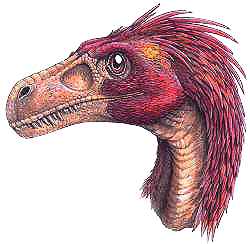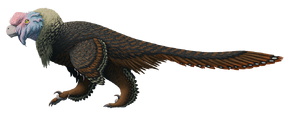

Dakotaraptor is an extinct genus of dromaeosaurs known from partial skeletons unearthed in South Dakota, USA. Its fossils have been found in the Maastrichtian-age Hell Creek Formation, dated to the very end of the Cretaceous (69-66 MYA) period, making it one of the last surviving dromeosaurids.
Size[]
A common misconception is that Dakotaraptor has surpassed Utahraptor as the largest dromaeosaurid, but this is untrue. Utahraptor was 7 metres (23 ft) and 500 kg (1,100 lbs), while Dakotaraptor was 6 metres (19.6 ft) and 453 kg (1,000 lbs). In addition to this, the two genera are very different proportion-wise; with Dakotaraptor being less heavily built and better adapted for speed than the more powerful Utahraptor.
Distinguishing Traits[]
Apart from the large size, the description of 2015 indicated some additional distinguishing traits.
Hind Legs[]
Overall, the hindlimb is built lightly and with long elements, contrary to the robust, stocky hind limbs of Utahraptor. Dakotaraptor more closely resembles the agile, springy smaller dromaeosaurids and would have been well-suited at running and pursuit predation. The length of the thighbone is 558 millimetres. It is relatively shorter and more lightly built than that of Utahraptor. To the contrary the shinbone is rather elongated. The holotype shinbone is with a length of 678 millimetres the longest dromaeosaurid tibia known. It is 22% longer than the thighbone, indicating a good running capability. The shinbone's cnemial crest has a sharp corner pointing to the front. Its fibular crest ends in a hook-shaped process pointing to above, a condition that is unique in the entire Theropoda. The astragalus and calcaneum, the upper ankle bones, are fused just as in Bambiraptor. The top of the calcaneum has but a small contact facet for the calfbone, indicating that this fibula must have had a very narrow lower end.
The metatarsus has an estimated length of thirty-two centimetres, which makes it rather long relative to the remainder of the hindlimb.
The foot claws of Dakotaraptor include a typical dromaeosaurid raptorial second claw, or "sickle claw", which was used for killing or holding down prey. It is large and robust with a diameter of sixteen centimetres and a length of twenty-four centimetres measured along the outer curve. This equals 29% of the length of the thighbone compared to 23% with Deinonychus. The claw is transversely flattened and has a droplet-shaped cross-section. The flexor tubercle, a large bump near the base, served as an attachment site for flexor muscles - the larger it was, the greater the slashing strength. Dakotaraptor has a flexor tubercle that is larger relative to overall claw size than it is in other discovered dromaeosaurids, potentially giving it the strongest slashing strength of any known member of this group. The flexor tubercle on the third claw of the foot is almost non-existent, very reduced in size compared to other dromaeosaurids, suggesting a more minimized use of that claw. As these are the bony cores of the claws, they would have been covered in a keratinous sheath that extended the "nail" and ended in a sharp tip. The third claw too is keeled but is much smaller with a tip to joint length of seven centimetres and a curve length of nine centimetres. The groove on its outer side towards the tip ends in a bone tunnel, a rare condition.
Forelimb[]
Like virtually all other theropods, Dakotaraptor possessed a furcula, or “wishbone”, as part of the shoulder girdle. Theropod wishbones are quite varied and often different from the strongly U-shaped furculae most modern birds possess. Dakotaraptor had a furcula that was U- to V-shaped, similar to many other dromaeosaurids such as Velociraptor, and even the large spinosaurid theropod Suchomimus. In 2015, a study by Victoria Megan Arbour e.a. claimed that the presumed Dakotaraptor furculae in fact represented a part of a turtle armour, the entoplastron of Axestemys, a member of the Trionychidae.
The second metacarpal of the metacarpus of the hand, the bone that primary remiges attach to, also had a flat bony shelf as its dorsal surface. The shelf made a perfect spot for the primary feathers to lay across in their life-attachment.
Vertebral column[]
The vertebrae of the back are highly pneumatised, filled with trabecular bone that shows many air spaces. On the middle tail vertebrae the front joint processes, theprezygapophyses, are extremely elongated with an estimated intact length of 70 centimetres, spanning about ten vertebrae. This stiffens the tail.
In the Media[]
- Dakotaraptor will be in the upcoming game Saurian as a playable dinosaur. In the game, it has the ability to pounce on prey and climb trees. It also shows limited parental care (cannibalizing smaller members of its own kind) and will gather into groups to mob prey. Juvenile Dakotaraptor have gliding abilities to help in escaping from hungry adults and other predators. It will also be the only playable dinosaur available on early release, with other species becoming playable later upon the game's completion.
- Dakotaraptor will also be in the upcoming game Mesozoica.
- The Dino Bird family in Ice Age: Collision Course are Dakotaraptors.
- Dakotaraptor appeared in Walking with Dinosaurs identified as Dromaeosaur.
